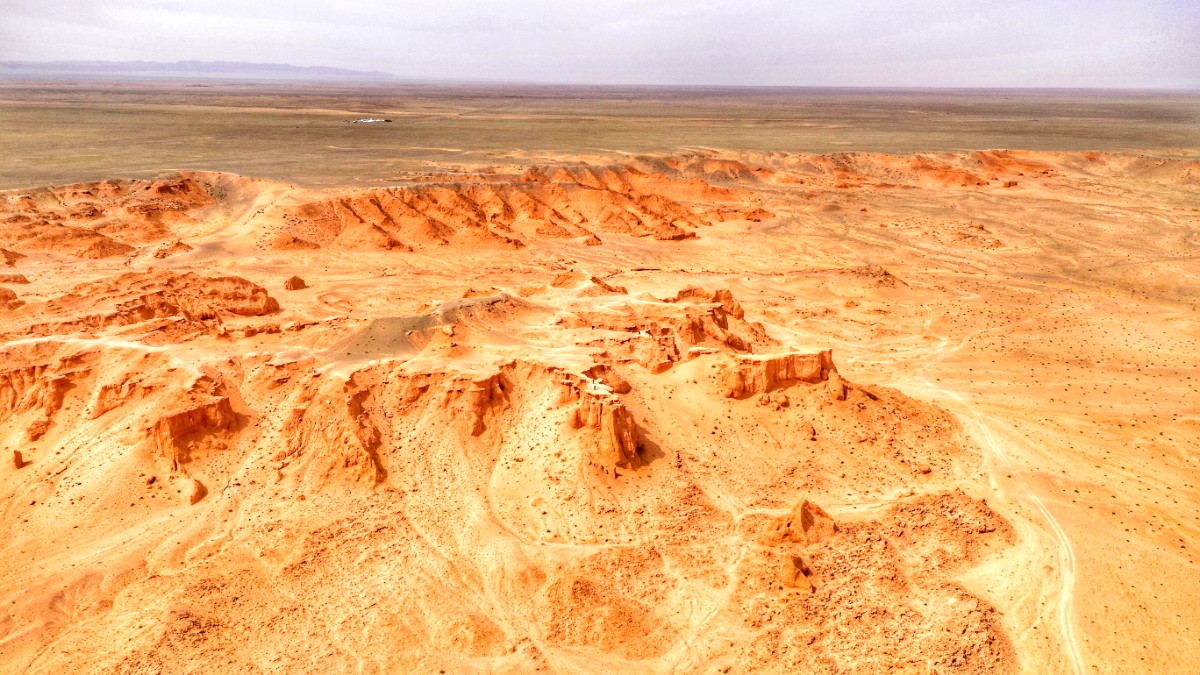
Mongolia
Certain sites in the Gobi are renowned globally for their natural beauty and scientific significance. Prepare for incredible geological formations and vast, open landscapes.
Visiting early morning or late afternoon for sites like Khongoryn Els and Bayanzag is best. This avoids midday heat and direct sun, and often means fewer tourists. For Yolyn Am, visit earlier in the morning before larger tour groups arrive to experience the canyon more peacefully.
Consider using GetYourGuide to book tours that include these iconic Gobi sites.
Khavtsgait Petroglyphs (ancient rock carvings depicting animals and human figures) are often included in Gobi tours.
Ongi Monastery Ruins (Ongiin Khiid), a large Buddhist monastery destroyed in the 1930s purges, are often visited on the way to or from the deep Gobi. A small active monastery has been rebuilt nearby.
Few active monasteries remain in the Gobi. You might encounter small local temples or ovoos (cairns, sacred sites) during your travels.
Not applicable for the Gobi. The nomadic lifestyle does not feature fixed historical districts or complex architecture.
These categories are not prominently featured as tourist attractions in the Gobi Desert's main areas.
Beyond the main landmarks, the Gobi's natural beauty extends to its vast parks and unique geological formations.
This is the main natural attraction, protecting the core Gobi sites. The Gobi Natural Reserve, further south, is home to rare species like the Gobi bear. Access is highly restricted and requires special permits.
Tsagaan Suvarga (White Stupa) is a striking geological formation resembling ancient ruins, with layered cliffs of various colors. This site is often included in Gobi tours.
Baga Gazryn Chuluu is a granite rock formation in Middle Gobi province, featuring interesting caves and a small temple ruin. Ulaan Suvarga (Red Stupa) is another similar red cliff formation.
Yolyn Am is known for pikas, ibex, and the Lammergeier vulture. Khongoryn Els offers opportunities to see gazelles. The Greater Gobi is home to wild Bactrian camels, Mongolian wild ass, and Mongolian gazelle.
Specialized tours might focus on spotting wild Bactrian camels or the elusive snow leopard and Gobi bear. Spotting these rare animals takes long, dedicated expeditions and luck.
These are limited to small, seasonal oases or spring-fed streams. No major lakes or beaches exist in the Gobi.
The Gobi Desert is a vast, cold desert plateau. Its landscapes include sand dunes, mountains, and rocky formations, making it geologically diverse.
The Gobi experiences extreme temperatures, with very cold winters and hot summers. Precipitation is minimal, defining its arid classification.
The Gobi is one of the world's most sparsely populated regions, home to nomadic herders who follow traditional lifestyles.
Seek out lesser-known spots for a more intimate Gobi experience.
When venturing into the vastness of the Gobi Desert for sightseeing, packing the right essentials and being prepared for the unique environment are important. The extreme climate and remote locations shape the experience.
Layered clothing is important due to significant temperature swings between day and night, even in summer. Sturdy walking shoes are for navigating varied terrain, from rocky canyons to soft sand dunes. Sun protection, including hats, sunglasses, and high-SPF sunscreen, is paramount under the intense Gobi sun. A reusable water bottle is a must for staying hydrated, as potable water sources are limited. Binoculars enhance wildlife viewing opportunities, while a good camera captures the dramatic landscapes. A reliable power bank is advisable for charging electronics, given limited electricity at ger camps.
Essentials for a comfortable and safe Gobi sightseeing experience.
Prioritize well-being when exploring the remote Gobi.
Manage expectations for communication and charging needs.
Maintain a low impact on the fragile desert ecosystem.
Planning your trip to the Gobi Desert, a vast and remote region, needs careful consideration of transportation, visa requirements, and local currency.
International flights arrive at Chinggis Khaan International Airport (ULN) in Ulaanbaatar. From there, domestic flights or overland travel continues to the Gobi.
Travel within the Gobi is mainly by 4x4 vehicle with a local driver and guide. Roads are unpaved tracks, requiring robust vehicles.
Visa requirements vary by nationality. Check with the Mongolian embassy or consulate in your country well in advance of your trip.
The official currency is the Mongolian Tugrik (MNT). It is advisable to carry enough cash, especially in smaller denominations, for purchases in rural areas.
Credit cards are rarely accepted outside Ulaanbaatar and a few larger hotels in provincial centers. ATMs are limited to major towns like Dalanzadgad.
The amount is at your discretion, usually based on the length and quality of the tour.
Most Gobi tours are all-inclusive, covering accommodation, transport, and meals. Factor in costs for souvenirs, drinks, and personal expenses.
Consider a small contingency fund for unforeseen circumstances or last-minute changes to your itinerary.
Booking through a reputable tour operator simplifies Gobi travel.
Timing your Gobi trip for optimal weather and events.
Learn a few basic Mongolian phrases. This shows respect and can enrich interactions with locals.
Carry small gifts for nomadic families if you plan a homestay; simple stationery or small toys for children are appreciated.
The Gobi Desert offers an extraordinary journey into a landscape of stark beauty and rich cultural heritage. From towering sand dunes to ancient dinosaur sites, it is a destination for adventurous travelers seeking unique natural wonders and authentic nomadic encounters.
The Gobi is defined by its dramatic and varied terrain.
Connect with the enduring nomadic culture.
The Gobi is an adventurer's dream, with diverse activities.
The raw natural environment offers many possibilities for exploration.
Preparation ensures a smoother journey.
Travel with an experienced guide for safety and cultural understanding.
Travel responsibly and respect the fragile desert environment and culture.
GetYourGuide.com for attraction and activity bookings.
Booking.com or Agoda.com for hotels in Ulaanbaatar.
Hostelworld.com for budget stays in Ulaanbaatar.